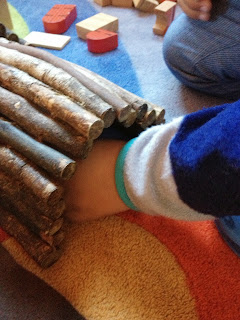If you have read my last post (here), you know how strong I feel about fairy tales. So, two weeks ago, we started reading the Little Red Hen as its moral teaching coincides with what we are working on with the children this September: work ethics, personal initiative, responsibility and cooperation and much much more.
Saturday, September 28, 2013
Fairy tales: Montessori versus Waldorf
Last week and this week, we have been working on the Little Red Hen story. I am trying this year to compliment our curriculum by integrating fairy tale - based projects and activities. Why? Because I have come to realise that fairy tales can carry all the important angles of our program. Fairy tales are timeless and they can open the door to many discussion, topics and issues. They work because the children love them and have heard about them already, one way or another.
As I explained before, Montessori doesn't agree with the use of fantasy in books. WHY? Simply because Montessori didn't believe that a young child is able to grasp abstract concepts and that children don't know what is real and what isn't. In the Montessori method of education, the young child (0-5) needs to know and understand the real world before they can appreciate and participate in a made up world of fantasy. Therefore, one of the main reasons why fantasy is not a part of the Montessori curriculum is because it "apparently" disorients young children. This is why Montessori doesn't encourage fantasy play and why in most Montessori preschools, you will not find a play corner or dress ups. This is also why Montessori refers to the activities of the child as “work” rather than play. These reality-based activities (like cutting, polishing, sweeping, cleaning, watering etc..) are important because the children see them as the work of adults (rather than the fantasy play that has no grounding in reality). Materials used in a Montessori classroom are real: there is no pretend kitchen but real plates, pots and utensils. And the children learn how to use them to make a snack for instance.
The most rigid Montessorian will explain to you that dramatic/imaginative play DOES take place in a Montessori classroom as for instance, when a child is preparing food, he/she often takes the role of the mother/the father. When he cuts paper in zigzag, he ends up with a crown he wears proudly as the new King in the classroom. And I do agree with this aspect of the method. Children do enjoy "working" with real apparatus. No plastic please, no fake forks and knives. Let them re-enact what they see at home.
Maria Montessori pushed the theory further by refusing to read fairy tales to the children as she believed that though beautiful stories, they had no place in a classroom at "work". Here is something I really struggle to reconcile with. So, if I was to follow the Montessorian method rigidly, having children believing in Santa and the Easter bunny would be harmful? Reading them stories about with animals that talk and act like us would be a bad thing to do? Having a bit of magic in their childhood can damage them? Rubbish!!! This is where I differ from the traditional Montessorisan teaching method. If the children do find it hard to draw a line between what's real and what 's not, it is only at their sweetest and youngest age and soon, reality sets in and set them straight (and nowadays, with the help of technology and media) it happens much sooner than before.. Not to my liking! Children do not grow up to believe that Dora the explorer is real. Have you ever heard a child saying that he believed monkeys talked and wore boots? While my son watched Thomas the Tank Engine, or Handy Mandy, he never expected to climb on a train or use a hammer and heard both of them say "hello" to him!!. These characters are fun and entertaining. Let's not put too much pressure too quick on little mind. And the process of realising what's real and what's not is part of a learning process and intellectual growth. This is why, even though we follow the Montessori method of Education, I do read fairy tales and many of our books have talking animals as main characters. And by incorporating storytelling and fantasy in our curriculum, we do as Waldorf recommended and we nourish the young child’s healthy imagination and creative thinking powers. This way, the children get the best of both worlds/dimensions: imagination through hand-on experiences (Montessori) and role play/dramatic play (Waldorf).
Labels:
literacy,
Montessori,
Reggio Inspired
Saturday, September 14, 2013
Expanding the lessons of the Kissing Hand
One of the books I like to use at the beginning of a school year is the Kissing Hand. It's about a little raccoon Chester who doesn't want to leave his mother to go to school.
Monday, September 9, 2013
How to build a castle...
I am so glad I have developed our new construction area in the classroom. We used to have one before but it was too small and it was shared with the reading corner, the circle time area and the science corner. Too much happening at the same place, too many kids wanting to use the mat at the same time. Less room for creativity and imagination. I read so much this summer and I came to firmly believe that I couldn't offer my children the learning experiences they needed without having a block corner. Blocks are the epitome of open-ended materials and they are a must if I want to allow children to express their creativity. When they design and build, they are learning, discovering, growing and developing skills essential to their understanding of the world around them. When a child plays with a block, he must think creatively, learn to solve problems, negotiate and invent. Building a tower or a bridge teaches them about balance, stability. They will also learn about symmetry. They make mistakes and learn at the same time. And hey, why don't you add mirror and see how suddenly, you have added a dimension of height and perspective to their learning too.
I was sitting on the mat with a group of children yesterday and asked them if I could look at them and if they could teach me how to build something with the wooden blocks. I sat very silently at the beginning and the children went on explaining to me what they were doing as they went on with their work. It was quite interesting. Look at this:
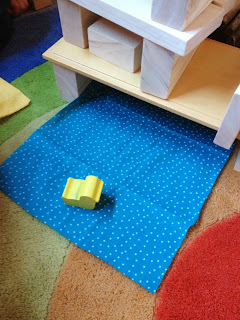 |
| Using blue fabric to create water under the castle |
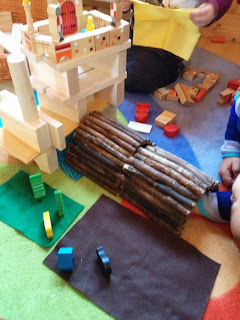 |
| Adding a bridge over the water, using brown felt for the animals in the field, and green felt for the forest! |
 |
| And here is a field of hay |
 |
| The children taught it would be easier for the people living in the castle to use stairs |
 |
| Pink fabric = field of pink flowers |
 |
| Adding a slide for the animals |
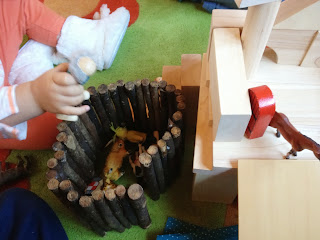 |
| a fence for the farm animals |
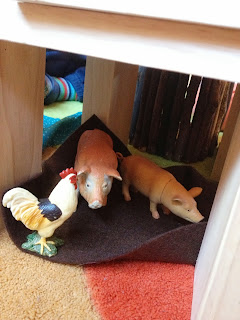 |
| Here are some animals under the second castle the children built. |
Mind blowing!!!
Labels:
construction,
maths,
pretend play,
Reggio Inspired
Planning our 1st provocation
We talked about how we wanted students to interact with our classroom. We didn’t want them to come in and know every day what the block area or the writing centre for instance contained . I want the children to arrive in class and wonder what they will come up with in each centre. the environment must be dynamic and evolve on a regular routine. Don't you agree that thanks to such a classroom, the children's interest and curiosity will grow? I have never put all the materials out at the beginning of the year. I gradually add, remove etc.. depending on the children's learning pace and their interests too. This is another aspect of creating a dynamic teaching environment. I have learnt that each year bring us a "bunch" of different kids who love doing things completely different than the past pupils. What Reggio teachers often do as well is add a new game/toy/apparatus etc.. and let the children discover it themselves.
From what I have studied so far, one of the most important concepts of the Reggio Emilia Approach is the "provocation". What I understand (and please correct me if I am wrong) is that a provocation could be an image, an object, a group of images or a group of objects. It could be a sound, a series of sounds, a piece of music. It could also be any event or experience that leads to more discussion, curiosity, excitement... Provocations can be pre-planned, structured and arranged while some of them are more open-ended.
So, I have been re-thinking activities in our classroom. I want them to be about exploration and discovery through their senses. I want the activities to prompt the children to ask more questions, to plan and to think deeply. To do so, I have to observe what the children are interested in or at least guess. I have to take into consideration what they already know and then plan the activity.
Here is the 1st provocation I set up. I had noticed the children looking at themselves in the various mirrors in the classroom. They have also been quite drawn to the writing centre to colour. I assumed that exploring a new art medium would be a great idea and I presented a mirror in the writing centre. I sat at the table beside a child and observed. It didn't take the child very long to start making faces in the mirror and start laughing saying : "look, this is another me and it is doing all what I am doing!".. So I prompted the child a bit further and asked him to describe himself. When he said he had brown eyes, I asked him if we had the same colour in our crayons basket. When he said he had dark yellow hair, I repeated the question. We moved on to the skin and the lips colour. Finally, I asked him what shape was his face? His eyes? His mouth? And the rest followed:
And funny enough, once we were finished, we had a group of children waiting for their turn to "draw themselves"!! Brilliant!
At circle time, I reinforce the concept of identity and we
talked with the children about how there are things about each
of them that are the same and there are things about each of them that are
different. We had all the preschoolers with blond hair to stand up ,all preschoolers who
have brown eyes to stand up. And we also read:
- I'm Glad to be Me by P.K. Hallinan
- I Know What I Like by Norma Simon
Subscribe to:
Posts (Atom)


